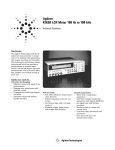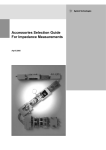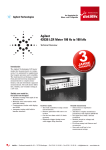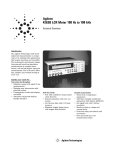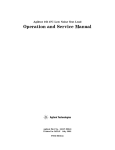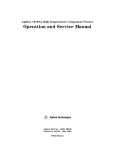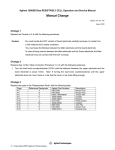Download Agilent Technologies 4263A Service manual
Transcript
Agilent 16060A Transformer Test Fixture Operation and Service Manual Agilent Part No. 16060-90000 Printed in JAPAN March 2000 Notice The information contained in this document is subject to change without notice. This document contains proprietary information which is protected by copyright. All rights are reserved. No part of this document may be photocopied, reproduced, or translated to another language without the prior written consent of the Agilent Technologies. Agilent Technologies Japan, Ltd. Component Test PGU-Kobe 1-3-2, Murotani, Nishi-ku, Kobe-shi, Hyogo, 651-2241 Japan Warranty This Agilent Technologies instrument product is warranted against defects in material and workmanship for a period of one year from the date of shipment, except that in the case of certain components listed in this manual, the warranty shall be for the specied period. During the warranty period, Agilent Technologies will, at its option, either repair or replace products which prove to be defective. For warranty service or repair, this product must be returned to a service facility designed by Agilent Technologies. The Buyer shall prepay shipping charges to Agilent Technologies and Agilent Technologies shall pay shipping charges to return the product to the Buyer. However, the Buyer shall pay all shipping charges, duties, and taxes for products returned to Agilent Technologies from another country. Agilent Technologies warrants that its software and rmware designed by Agilent Technologies for use with an instrument will execute its programming instruction when property installed on that instrument. Agilent Technologies does not warrant that the operation of the instrument, or software, or rmware will be uninterrupted or error free. Limitation of Warranty The foregoing warranty shall not apply to defects resulting from improper or inadequate maintenance by the Buyer, Buyer-supplied software or interfacing, unauthorized modication or misuse, operation outside of the environmental specications for the product, or improper site preparation or maintenance. No other warranty is expressed or implied. Agilent Technologies specically disclaims the implied warranties of merchantability and tness for a particular purpose. Certication The Agilent Technologies certies that this product met its published specications at the time of shipment from the factory. Agilent Technologies further certies that its calibration measurements are traceable to the United States National Institute of Standards and Technology, to the extent allowed by the Institute's calibration facility, or to the calibration facilities of other International Standards Organization members. Exclusive Remedies The remedies provided herein are the buyer's sole and exclusive remedies. Agilent Technologies shall not be liable for any direct, indirect, special, incidental, or consequential damages, whether based on contract, tort, or any other legal theory. Assistance Product maintenance agreements and other customer assistance agreements are available for Agilent Technologies products. If you need assistance, contact your nearest Agilent Technologies Sales and Service Oce. Addresses are provided at the back of this manual. c Copyright 1991, 2000 Agilent Technologies Japan, Ltd. Manual Printing History The manual printing date and part number indicate its current edition. The printing date changes when a new edition is printed. (Minor corrections and updates which are incorporated at reprint do not cause the date to change.) The manual part number changes when extensive technical changes are incorporated. November 1991 First Edition (part number: 16060-90000) March 2000 Second Edition (part number: 16060-90000) :::::::::::::::::::::::::::::::::::::: :::::::::::::::::::::::::::::::::::::::: iv Safety Summary The following general safety precautions must be observed during all phases of operation, service, and repair of this instrument. Failure to comply with these precautions or with specic WARNINGS given elsewhere in this manual violates safety standards of design, manufacture, and intended use of the instrument. The Agilent Technologies assumes no liability for the customer's failure to comply with these requirements. Do NOT operate in an Explosive Atmosphere Do not operate the instrument in the presence of ammable gasses or fumes. Operation of any electrical instrument in such an environment constitutes a safety hazard. Keep Away from Live Circuits Operating personnel must not remove instrument covers. Component replacement and internal adjustments must be made only by qualied maintenance personnel. Do not replace components with the power cable connected. Under certain conditions, dangerous voltages may exist even with the power cable removed. To avoid injury, always disconnect power and discharge circuits before touching them. Do NOT Service or Adjust While Alone Do not attempt internal service or adjustment unless another person, capable of turning o power and capable of rendering rst aid and resuscitation, is present. Do NOT Substitute Parts or Modify Instrument Because of the danger of introducing additional hazards, do not substitute parts or perform unauthorized modications to the instrument. Return the instrument to a Agilent Technologies Sales and Service Oce for service and repair to ensure the safety features are maintained. Dangerous Procedure Warnings Warnings, such as the example below, precede POTENTIALLY DANGEROUS PROCEDURES throughout this manual. Instructions contained in the warnings must be followed. Warning Dangerous voltages, capable of causing death, are present in this instrument. Use extreme caution when handling, testing, and adjusting this instrument. v Safety Symbols General denitions of safety symbols used on equipment or in manuals. Instruction manual symbol: the product will be marked with this symbol when it is necessary for the user to refer to the instruction manual in order to protect against damage to the instrument. Indicates dangerous voltage (terminals fed from the interior by voltage exceeding 1000 volts must be so marked). Protective ground terminal. For protection against electrical shock in case of a fault in the instrument. Used with wiring terminals to indicate the terminal which must be connected to ground before operating equipment. Low-noise or noiseless, clean ground (earth) terminal. Used for a signal common, as well as providing protection against electrical shock in case of a fault in the instrument. A terminal marked with this symbol must be connected to ground in the manner described in the installation (Operation) manual, and before operating the equipment. Frame or chassis terminal. A connection to the frame (chassis) of the equipment which normally includes all exposed metal structures. Alternating current (power line). Direct current (power line). Alternating or direct current (power line). Warning denotes a hazard. It calls attention to a procedure, practice, condition or the like, which, if not correctly performed or adhered to, could result in injury or death to personnel. Caution sign denotes a hazard. It calls attention to a procedure, practice, condition or the like, which, if not correctly performed or adhered to, could result damage to or destruction of part or all of the product. Note denotes important information. It calls attention to a procedure, practice, condition or the like, which is essential to highlight. vi Contents 1. General Information 2. Preparation for Use 3. Operation 4. Service Introduction . . . . . . . . . . . . . . . Using the 16060A . . . . . . . . . . . . Product Description . . . . . . . . . . . Accessories Supplied . . . . . . . . . . . Operating And Safety Precautions . . . . Operating . . . . . . . . . . . . . . . Service . . . . . . . . . . . . . . . . Specications . . . . . . . . . . . . . . Supplemental Performance Characteristics . . . . . . . . . . . . . . . . . . . . . . . . . . . . . . . . . . . . . . . . . . . . . . . . . . . . . . . . . . . . . . . . . . . . . . . . . . . . . . . . . . . . . . . . . . . . . . . . . . . . . . . . . . . . . . . . . . . . . . . . . . . . . . . . . . . . . . . . . . . . . . . . . . . . . . . . . . . . . . . . . . 1-1 1-1 1-1 1-1 1-2 1-2 1-2 1-3 1-3 . . . . . . . . . . . . . . . . . . . . . . . . . . . . . . . . . . . . . . . . . . . . . . . . . . . . . . . . . . . . . . . . . . . . . . . . . . . . . . . . . . . . . . . . . . . . . . . . . . . . . . . . . . . . 2-1 2-1 2-3 2-3 2-3 2-4 Introduction . . . . . . . . . . . . . . . . . . OPEN Correction . . . . . . . . . . . . . . . Operation . . . . . . . . . . . . . . . . . . . How to Connect to Autotransformer . . . . . To Disconnect the Transformer Being Measured How to Use the A:B Switch . . . . . . . . . . How to Extend the Test Leads . . . . . . . . . Internal Circuit of the 16060A . . . . . . . . . . . . . . . . . . . . . . . . . . . . . . . . . . . . . . . . . . . . . . . . . . . . . . . . . . . . . . . . . . . . . . . . . . . . . . . . . . . . . . . . . . . . . . . . . . . . . . . . . . . . . . . . . . . . . . . . . . . . . . . . . 3-1 3-2 3-3 3-4 3-4 3-5 3-5 3-6 Introduction . . . . . . . . . . . . . . . . . . . . . . . . . . . . . . . . . Replaceable Parts . . . . . . . . . . . . . . . . . . . . . . . . . . . . . . 4-1 4-1 Introduction . . . . . . . . . . . . Initial Inspection . . . . . . . . . . Environment Considerations . . . . Operating and Storage . . . . . . Connecting The Test Fixture For Use Repackaging the Test Fixture . . . . . . . . . . . . . . . . . . . . . . Contents-1 Figures 2-1. 2-2. 3-1. 3-2. 3-3. 3-4. 3-5. Product Overview . . . . . . . Connecting the Test Fixture . . Test Fixture Features . . . . . . Making an OPEN . . . . . . . Connecting a Transformer . . . Connecting an Autotransformer . Internal Circuit of the 16060A . . . . . . . . . . . . . . . . . . . . . . . . . . . . . . . . . . . . . . . . . . . . . . . . . . . . . . . . . . . . . . . . . . . . . . . . . . . . . . . . . . . . . . . . . . . . . . . . . . . . . . . . . . . . . . . . . . . . . . . . . . . . . . . . . . . . . . . . . . . . . . . . . . . . . . . . . . . 2-2 2-3 3-1 3-2 3-3 3-4 3-6 Furnished Accessories . . . . . . . . . . . . . . . . . . . . . . . . . . Contents . . . . . . . . . . . . . . . . . . . . . . . . . . . . . . . . Relationship Between the A:B Switch Position and Measurement Parameters Replaceable Parts List . . . . . . . . . . . . . . . . . . . . . . . . . . . . . . 1-1 2-2 3-5 4-1 Tables 1-1. 2-1. 3-1. 4-1. Contents-2 1 General Information Introduction The purpose of this manual is to enable you to use your 16060A Transformer Test Fixture eciently and condently. This manual contains both general and specic information. To use the 16060A to perform a specic function (without having to read the entire manual), follow the directions in \Using the 16060A". Using the 16060A To install the 16060A, turn to Chapter 2. To operate the 16060A, turn to Chapter 3. To order replaceable parts for the 16060A, turn to \Replaceable Parts" in Chapter 4. Product Description The 16060A has been designed to operate specically with Option 001 \Add N/M/DC-R Measurement Function" of 4263A LCR Meter. The 16060A provides a convenient means of measuring a transformer's self-inductance, mutual inductance, turns ratio, and dc resistance in the frequency range of dc to 100 kHz, as appropriate for each measurement. Accessories Supplied The following accessories are supplied with the 16060A: Table 1-1. Furnished Accessories Description Operation and Service Manual Test Leads (black) Test Leads (red) Part Number P/N 16060-90000 P/N 16060-61601 P/N 16060-61602 Quantity 1 2 2 General Information 1-1 Operating And Safety Precautions Operating You need observe only normal precautions when handling and operating the 16060A. Do not exceed the operating input power, voltage, and current level and signal type appropriate for the instrument being used, refer to your instrument's operation manual. Caution Electrostatic discharge (esd) can damage the highly sensitive microcircuits in your instrument. ESD damage is most likely to occur when the test xture is being connected or disconnected. Protect the 16060A from ESD damage by wearing a grounding strap that provides a high resistance path to ground. Alternatively, ground yourself to discharge any static charge build-up by touching the outer shell of any grounded instrument chassis before touching the test port connectors. Never touch a test port connector's center contact. Use a work station equipped with an anti-static work surface. Service The voltage levels in this xture do not warrant more than normal caution for operator safety. Nevertheless, service should be performed only by qualied personnel. 1-2 General Information Specications This section lists the complete 16060A specications. These specications are the performance standards and limits against which the 16060A is tested. When shipped from the factory, the 16060A meets the following specications: Measurement Parameters L, N, M, and DCR Frequency Range DC to 100 kHz Applicable Instrument 4263A with Option 001 Weight 300 g Operating Temperature 0 to 55 C Operating Humidity 95% RH (@40 C) Non-operating Temperature 040 to 70 C Non-operating Humidity 95% RH (@65 C) ::::::::::::::::::::::::::::::::::::::::::::::::::::: ::::::::::::::::::::::::::::::::::::::::::::::::::::::::::::::::: :::::::::::::::::::::::::::::::::::::::::::::::::: :::::::::::::::::::::::::::::::::::::::::::::::::::::::::::::::::::::::::::::::::::::: :::::::::::::::::::::::::::::::::::::::::::::::::::::::::::::::: :::::::::::::::::::::::::::::::::::::::::::::::::::::::::: :::::::::::::::::::::::::::::::::::::::::::::::::::::::: :::::::::::::::::::::::::::::::::::::::::::::::::::::: Supplemental Performance Characteristics This section gives supplemental performance characteristics. Supplemental performance characteristics are not specications, but are typical characteristics included as additional information for the operator. Supplemental performance characteristics are not guaranteed. Cable Length 25 cm Dimensions 90 mm (w) 2 35 mm (h) 2 90 mm (d) Applicable DUT Size Diameter of DUT's terminals 4 mm :::::::::::::::::::::::::::::::::::::::::::::::::::::::::::::::::::::::::::::: ::::::::::::::::::::::::::::::::::::::::::::::: ::::::::::::::::::::::::::::::::::::::::::::::::::::::::::::: General Information 1-3 2 Preparation for Use Introduction This chapter explains how to install the 16060A Transformer Test Fixture. The topics covered include initial inspection, ambient environmental considerations, connecting the test xture for use, and repackaging the test xture for shipping. Initial Inspection This xture has been carefully inspected electrically and mechanically before being shipped from the factory. It should be in perfect physical condition, no scratches, dents or the like, and it should be in perfect electrical condition. Verify this by carefully performing an incoming inspection to check the test xture for signs of physical damage and missing contents. If any discrepancy is found, notify the carrier and Agilent Technologies. Your Agilent Technologies sales oce will arrange for repair and replacement without waiting for the claim to be settled. 1. Inspect the shipping container for damage, and keep the shipping materials until the inspection is completed. 2. Verify that the shipping container contains everything shown in Figure 2-1 and listed in Table 2-1. 3. Inspect the exterior of the 16060A for any signs of damage. Preparation for Use 2-1 Figure 2-1. Product Overview Table 2-1. Contents Description 1 Transform Test Fixture 2 Test Lead (black) 3 Test Lead (red) 4 Operation and Service Manual2 Agilent Part Number Quantity 16060-600011 16060-61601 16060-61602 16060-90000 1 2 2 1 1 Agilent internal-only part number. 2 Operation and Service Manual is not shown in Figure 2-1. 2-2 Preparation for Use Environment Considerations Operating and Storage The 16060A should be operated within an ambient temperature range of 0 C to 55 C and relative humidity up to 95% at 40 C (non-condensing). The 16060A may be stored within a temperature range of 040 C to +70 , and at a relative humidity of up to 95% at +65 C (non-condensing). Connecting The Test Fixture For Use Figure 2-2. Connecting the Test Fixture Preparation for Use 2-3 Repackaging the Test Fixture If shipping to a Agilent Technologies service center is required, the test xture should be repackaged using the original factory packaging materials. Alteratively, comparable packaging materials may be used. Wrap the test xture in heavy paper and pack in anti-static plastic packing material. Use sucient shock absorbing material on all sides of the 16060A to provide a thick, rm cushion and to prevent movement during shipping. Seal the shipping container securely and mark it FRAGILE. 2-4 Preparation for Use 3 Operation Introduction This chapter describes the features of the 16060A (Figure 3-1), and describes how to connect a transformer to the test xture (Figure 3-3 and Figure 3-4), how to set the A:B switch for dierent measurements, how to physically extend the measurement distance from the 4263A using cables and test leads, and describes the internal circuit of the 16060A. For instructions on how to measure transformer parameters, see the 4263A Operation Manual. Figure 3-1. Test Fixture Features 1. Four terminal pair BNC terminals. These terminals are connected to the UNKNOWN terminals of the 4263A. 2. A:B Switch. Switch A:B changes the connection between terminal \A" and terminal \B" to select the transformer parameter to be measured. 3. COMMON terminals. These terminals are connected using test leads to the common (low) terminals of the transformer to be measured as shown in Figure 3-3 and Figure 3-4. Operation 3-1 4. A terminal. Terminal A is connected using a test lead to one of the high terminals of the transformer under test as shown in Figure 3-3 and Figure 3-4. 5. B terminal. Terminal B is connected using a test lead to the other high terminal of the transformer under test as shown in Figure 3-3 and Figure 3-4. OPEN Correction The 16060A has inherent stray capacitance that adds an error term which decreases measurement accuracy. To cancel these residual eects and thus minimize measurement error, use the measuring instrument's OPEN correction capability. The procedure is described in the instrument's operation manual. To make an OPEN setup for this procedure, connect the center conductors of \A" and \B" together by clipping the respective alligator clips together, and separate them from the likewise connected center conductors of the COMMON terminals. Figure 3-2 illustrates an OPEN connection setup. Figure 3-2. Making an OPEN Note 3-2 Operation The eects of the 4263A SHORT correction depend on the measurement parameters. For more information on the SHORT correction function, see the 4263A Operation Manual. Operation 1. 2. 3. 4. Connect the 16060A to the UNKNOWN terminals of the 4263A. Connect the furnished BNC test leads to the 16060A. Perform an OPEN correction as described in the 4263A Operation Manual. Connect the respective alligator clips to the transformer to be measured as follows: a. When switch A:B is set to 1:N, rst connect the alligator clips of the COMMON terminals and terminal A to the transformer before connecting the alligator clip from terminal B. b. When switch A:B is set to N:1, rst connect the alligator clips of the COMMON terminals and terminal B to the transformer before connecting the alligator clip from terminal A. Warning Terminal B is connected to terminal Hcur when switch A:B is set to 1:N, or terminal A is connected to terminal Hcur when the switch A:B is set to N:1. While terminal Hcur of the 4263A is connected to a terminal of the transformer, high-voltage induction may occur at the other terminals. For operator safety, when connecting the transformer, follow the above mentioned connection order. 5. The Figure 3-3 and Figure 3-4 show the connecting a transformer. Figure 3-3. Connecting a Transformer Note When the transformer to be measured has a terminal common to both the transformer's primary and secondary (for example: an autotransformer), connect the COMMON terminals of the 16060A to the common terminal of the transformer, because the COMMON terminals of the 16060A are connected together inside in the 16060A. (See Figure 3-4 and Figure 3-5.) Operation 3-3 How to Connect to Autotransformer When the 16060A is used to measure an autotransformer, connect the test leads as shown in Figure 3-4. Figure 3-4. Connecting an Autotransformer To Disconnect the Transformer Being Measured Warning Terminal B is connected to terminal Hcur when switch A:B is set to 1:N, or terminal A is connected to terminal Hcur when the switch A:B is set to N:1. While terminal Hcur of the 4263A is connected to a terminal of the transformer, high-voltage induction may occur at the other terminals. For operator safety, when disconnecting the transformer, follow the disconnection order given below: When switch A:B is set to 1:N, rst disconnect the alligator clip of terminal B from the transformer before disconnecting the alligator clips of the COMMON terminals and terminal A. When switch A:B is set to N:1, rst disconnect the alligator clip of terminal B from the transformer before disconnecting the alligator clips of the COMMON terminals and the terminal B. 3-4 Operation How to Use the A:B Switch The 4263A can measure self-inductance (L2), DCR (R2), mutual inductance (M), and the turns ratio (N) of a transformer. (the 2 following L and R means these parameters are measured using the two-terminal measurement conguration.) When the A:B switch is set to \1:N", the 4263A can measure the L2, R2 parameters of the transformer winding connected to the \B" terminal and the turns ratio N as nb divided by na . (na means the number of turns in the transformer winding connected to \A" and nb means the number of turns in the transformer winding connected to \B".) When the A:B switch is set to \N:1", the 4263A can measure the L2 and R2 parameters of the transformer winding connected to the \A" terminal and the turns ratio N as na divided by nb . Note Set the switch to the opposite position if 4263A displays \OVLD" as the measured value of N. The 4263A cannot measure values of N less than 0.9, and \OVLD" means that the measurement result is out of range. The following table summarizes the relationship between the A:B switch position and the parameters the 4263A measures. Table 3-1. Relationship Between the A:B Switch Position and Measurement Parameters Switch Position L2 Measurement Parameter R2 N 1:N Self inductance of the DCR of the transformer winding transformer winding connected to \B" connected to \B" nb / na ( 0.9 )1 N:1 Self inductance of the DCR of the transformer winding transformer winding connected to \A" connected to \A" na / nb ( 0.9 )1 M Mutual inductance 1 na is the number of turns in the winding connected to \A", nb is the number of turns in the winding connected to \B". How to Extend the Test Leads When you extend the test leads to keep the DUT away from the 4263A, extend the BNC cables between the 16060A and the 4263A and keep the test leads between the 16060A and the transformer being measured as short as possible because the terminal conguration between the 4263A and the 16060A is a four-terminal pair (4TP) conguration and the conguration between the 16060A and the DUT is a two-terminal (2T) conguration. The eect of residuals on a measurement due to extended 4TP conguration test leads is less than that of the eects due to the 2T test lead conguration. To extend the 4TP conguration, use an 16048A (1 m), 16048D (2 m), or 16048E (4 m) BNC cables. To connect these extension leads and 16060A, four female-female BNC adapters (Agilent part number:1250-0080) are required. Operation 3-5 Internal Circuit of the 16060A Figure 3-5. Internal Circuit of the 16060A Note 3-6 Operation The measurement terminal conguration changes from four-terminal pair to two-terminal on the DUT side of the 16060A (at the point inside the box where the 4TP conguration changes to the 2T conguration). Setting the A:B switch to 1:N connects the Hcur terminal to the B terminal and connects the Hpot terminal to the A terminal. Setting the A:B switch to N:1 connects the Hcur terminal to the A terminal and connects the Hpot terminal to the B terminal. 4 Service Introduction This chapter gives Replaceable Parts service information for the 16060A. Replaceable Parts Table 4-1 lists the replaceable parts. The parts listed in this table can be ordered from your nearest Agilent Technologies Service oce. Ordering information should include the Agilent part number and the quantity required. Table 4-1. Replaceable Parts List Part Number Qty. 16060-04001 16060-04002 0515-0914 16060-66501 3101-2850 0515-1550 1250-0118 1250-1798 16012-7122 2190-0016 2950-0001 16060-61601 16060-61602 1 1 2 1 1 4 4 2 2 8 8 2 2 Description Chassis Top Cover Chassis Screw Flat Head M320.5 L6 PC Board1 Switch Slide Screw Pan Head M320.5 L8 Connector BNC (f) Connector BNC (m) Connector BNC (m) w/ Lever Washer (for BNC Connector) Nut (for BNC Connector) Cable Assy w/ Black Alligator Clip Cable Assy w/ Red Alligator Clip 1 Includes Slide Switch Service 4-1 REGIONAL SALES AND SUPPORT OFFICES For more information about Agilent Technologies test and measurement products, applications, services, and for a current sales office listing, visit our web site: http://www.agilent.com/find/tmdir. You can also contact one of the following centers and ask for a test and measurement sales representative. 11/29/99 United States: Agilent Technologies Test and Measurement Call Center P.O.Box 4026 Englewood, CO 80155-4026 (tel) 1 800 452 4844 Canada: Agilent Technologies Canada Inc. 5150 Spectrum Way Mississauga, Ontario L4W 5G1 (tel) 1 877 894 4414 Europe: Agilent Technologies Test & Measurement European Marketing Organization P.O.Box 999 1180 AZ Amstelveen The Netherlands (tel) (31 20) 547 9999 Japan: Agilent Technologies Japan Ltd. Call Center 9-1, Takakura-Cho, Hachioji-Shi, Tokyo 192-8510, Japan (tel) (81) 426 56 7832 (fax) (81) 426 56 7840 Latin America: Agilent Technologies Latin American Region Headquarters 5200 Blue Lagoon Drive, Suite #950 Miami, Florida 33126 U.S.A. (tel) (305) 267 4245 (fax) (305) 267 4286 Australia/New Zealand: Agilent Technologies Australia Pty Ltd 347 Burwood Highway Forest Hill, Victoria 3131 (tel) 1-800 629 485 (Australia) (fax) (61 3) 9272 0749 (tel) 0 800 738 378 (New Zealand) (fax) (64 4) 802 6881 Asia Pacific: Agilent Technologies 24/F, Cityplaza One, 1111 King’s Road, Taikoo Shing, Hong Kong (tel) (852)-3197-7777 (fax) (852)-2506-9284

























